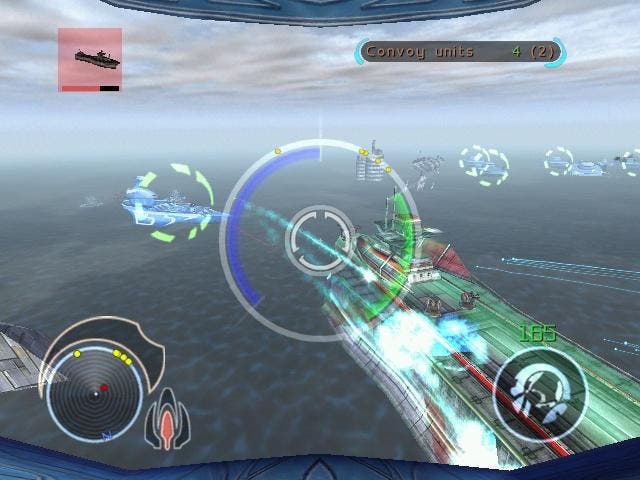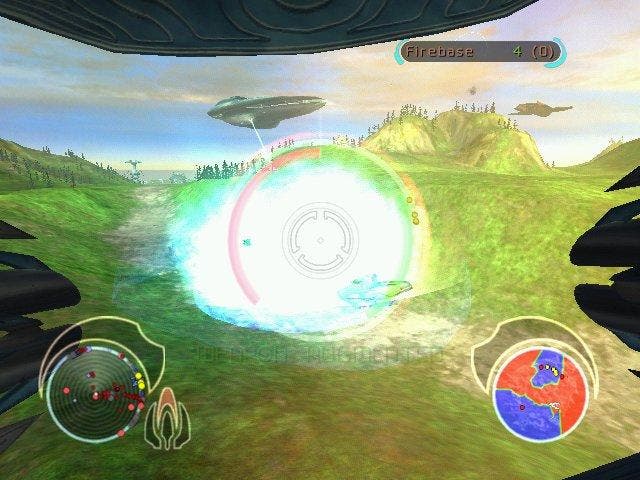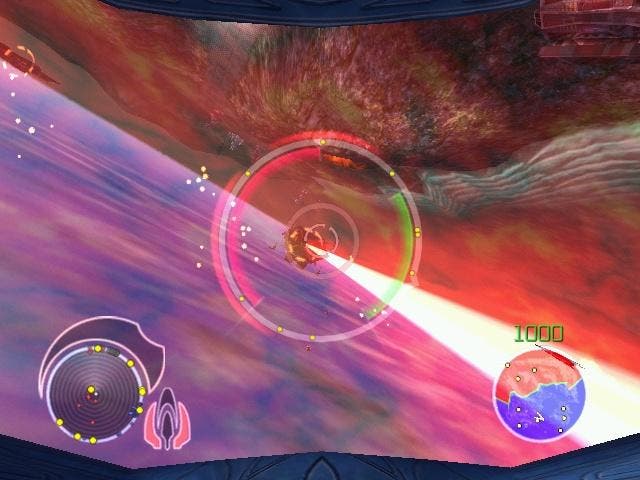Battle Engine Aquila
Rob gets his travel on for Lost Toys' ambitious mech 'em up
We've been tracking the progress of Battle Engine Aquila, an epic-scale shoot 'em up from British developer Lost Toys, with quite a degree of interest for some time now, as regular readers of the site will know. The game's premise is an interesting one - a hardcore shoot 'em up with the added depth of a full scale war going on in real-time around you, the outcome of which your actions can affect in a very direct way - and when we posted first impressions of the game back in January, we were certainly impressed with what we'd seen of the game so far.
Now that the much-delayed launch of the title is nearly upon us (the game was finished and meant to appear in stores last year, but was slipped in order to avoid the Christmas bloodbath), we've had a much more in-depth look at the game - with the question to answer being whether it can live up to its early promise, or if this is an innovative concept that falls over in the execution?

We Love Mechs
At first glance, the game is a simple one - you play Hawk, a young pilot who is drafted in during a military crisis to fly a unique prototype fighting machine after all of the test pilots are killed by an enemy operative. This machine (the Battle Engine itself) is a combined land and air assault unit, which switches from a ground-based walker mode into a flying jet at the touch of a button. Each mode has a deadly arsenal of weapons at its disposal, with the weapons in walker mode being more powerful but the flight weapons arguably more versatile. You can only stay in flight mode for a certain amount of time - while flying, your energy meter gradually drops, and when it runs out you come crashing to the ground, where it recharges again quite quickly.
Safely tucked into your fearsome mech, you're dropped into a number of major engagements between your troops (the Forseti) and the bad guys (the Muspell). Each mission takes place on an island, and although the mission objectives vary, the general objective is the same - win the battle and take over the island. You're not fighting alone, of course, and will usually have tanks, troopers and even artillery fighting alongside you, as well as a wingman - introduced after the first few levels - who'll help you mop up the enemy forces.
The controls are pretty easy to get to grips with, and there's a competent (but sadly non-optional) training level at the start of the game which gives you a chance to familiarise yourself with them. Most people will probably find that they're buzzing around like pros by the time they've done the first couple of levels, and the game is certainly a lot of fun right from the outset - with huge play areas, powerful weapons and literally hundreds of targets for your guns.

Hidden Depths
Although you can play the first few levels quite happily as a pure shoot 'em up, just running around the battlefield destroying everything in sight, the chances are that you'll start to notice a few things in the process which later become essential. Firstly, your allied troops are pretty intelligent - if you make a gap in the enemy defences, they'll take advantage of it and rout the enemy in that area, while if they're being hammered in a certain part of the battlefield, a few well-placed shots from you into the enemy ranks will give them the upper hand again. Although you can't explicitly order your troops to do anything, this does give you a great deal of control over the battle, and it sometimes starts to feel like you're backing your troops up as much as they're backing you up - which is an interesting and enjoyable first for an action game.
The progress of the battle as a whole is indicated by a "battle line" in the bottom right hand corner of the screen, which allows you to see where your troops are making progress and where the enemy is breaking through. Unfortunately this indicator isn't always particularly useful - on some levels where you're making a beachhead on hostile territory, the battle line doesn't accurately represent the state of play in the game at all, with huge swathes of map marked as enemy territory because there are a couple of stray infantrymen with machineguns wandering around aimlessly posing no threat to anyone in them. However, in general the indicator works well, and can be a very handy indicator of where you should devote your attentions at any particular point while playing.
This is where the real ambition of the game can be found; it's effectively a massive strategy game being fought out between two computer AI players, and you're the only wild card in the whole thing, so your actions will determine the outcome of the battle. For the most part, this approach works wonderfully, and it gives a whole level of depth to the game which many similar shoot 'em up titles have lacked. It also makes failing any given mission less frustrating than you might expect, because you haven't necessarily failed because the mission is simply too difficult - you've failed because you didn't notice a winning strategy, and it's fun to play through again and try new approaches to winning the battle.

Variety - the spice of life?
In fact, the only places where the game seems to fall off the rails a bit are in levels which are obviously designed to provide variety, by giving mission objectives which differ from the normal "lead an assault force and capture this island" type. Although some of these missions are certainly fun - an early mission involving escorting a convoy at sea springs to mind, as does a later one in which you must destroy radar installations on an enemy island using a cloaking device - others can be the source of toe-curling frustration, with objectives which seem to have been tacked on to otherwise perfectly reasonable missions in order to ramp up the difficulty and avoid repetition.
A good example is a later mission in which you must destroy anti-aircraft emplacements on an island - but the invasion of the island has already started, so the skies are filled with your planes, and of course you cannot allow too many of them to be destroyed or you fail the mission. This arbitrary objective is deeply annoying, mostly because while you're off on this wild goose chase, at the other end of the island your landing force is establishing a beachhead - and their job sounds like much more fun. Meanwhile, your idiot flyboys are being cut to ribbons, and whether you can take down the air defences in time to save them seems almost totally random, because your allies quite happily fly all over the map in pursuit of enemies - sometimes avoiding being shot down for ages, sometimes being blown out of the sky within seconds of the mission starting. Besides - what kind of stupid military commander sends in the air support before the AA batteries have been taken out?
In fact, as we progressed through the game, we often found ourselves wishing not for more variety, but for less - more missions which are focused on establishing beachheads and leading your troops on an invasion of the island would have been welcome, with fewer arbitrary objectives or unfair conditions for failing missions. This is our biggest criticism of the game by far - while some missions are simply fantastic, others are let down by being either too complicated for their own good or insanely difficult for the wrong reasons. It should be noted, however, that the positive features of the gameplay outweigh the negative ones massively, and the very fact that we were frustrated by these deviations from the core gameplay mechanic should point at just how much fun the game is when it's being more straightforward.

Son et Lumiere
The graphics in Aquila are well up to the task of rendering the large battlefields and massive armies very well, with a consistently high framerate and very nice explosion and weapon effects. The models in the game aren't shockingly detailed, but they're extremely well designed and often very imaginative - we especially liked the enemy's spider-type mech units, and some of the bosses (yes, there are bosses!) are very nicely designed. The lack of detail on the models is for a good reason anyway - the game throws around literally hundreds of them at once, and the epic scale of the battles is something we've genuinely never seen before in a game. The PS2 graphics are particularly noteworthy - although the game is no graphical slouch on the Xbox by any means, it's up to a very similar level of quality on the PS2, and is certainly pushing the machine very very hard indeed. It's rare to see a multi-platform game that shows off the hardware of both platforms so effectively, and Lost Toys are to be commended highly for that.
Although the Xbox version does look slightly better in places than its PS2 counterpart, anyone considering buying the game on the PS2 should probably actually bump the final score up a notch, because the game is stunningly impressive looking on the PS2, whereas Xbox owners spoiled by the likes of Halo are less likely to find the graphics jawdropping.
The only big flaw in terms of presentation and graphics is the cut scenes, which are very poor indeed. Although the vehicles are rendered quite nicely, the human characters are simply downright ugly; however, the cut scenes are short and functional, and serve only to provide the thinnest veneer of plot over the action. The voice acting, both in the cut scenes and in the game itself, is remarkably good by videogame standards - it certainly has its fair share of unintentionally funny voice acting bloopers, but then again, the plot was hardly meant to be taken very seriously anyway.
On the topic of audio, it's worth mentioning the soundtrack for the game, which was put together by Tomb Raider composer Nathan McCree and is a very fine piece of work indeed, with stirring orchestral themes that wouldn't be out of place in a big-budget action movie. The rest of the sound effects in the game are pretty much as you'd expect from an action title - lots of explosions and gunfire noises, creating a wartime soundscape that's perfectly functional if a bit unremarkable. Still - the music more than makes up for any deficiency in this area, so it's a definite thumbs up in the audio department.

Multi-player Engine
The game does feature a limited range of split-screen multi-player modes, including a fairly pointless deathmatch mode and a much more interesting co-operative mode. There's also an interesting bonus in the form of several racetrack levels which can be unlocked by achieving certain ranks in the game - these are a surprising amount of fun, albeit something of a short lived distraction. Overall, however, you won't be buying Battle Engine Aquila for multi-player options - it's a single-player game at heart, and the multi-player functions do feel like a bit of a token effort.
After a lot of time spent playing Battle Engine, the fact is that the game is still a lot of fun, and we're looking forward to getting back into it and trying to improve our rankings on some of the levels we failed to get high grades on (each level gives you a ranking when you complete it, and if you manage to complete the optional secondary objectives as well, you unlock a more difficult "Evo" version of the next level). The pure shoot 'em up component of the game is a lot of fun regardless of the tactical depths, and we've enjoyed finding some of the neat tricks that can be performed with the Battle Engine - such as transforming into walker mode while above an enemy aircraft, landing on top of it, destroying while your energy gauge refills and then hopping off when it explodes to move on to the next target.
That's perhaps the beauty of Battle Engine in a nutshell; it's a game where you keep on finding cool new things to do, ranging from unexpected uses for your weapons to interesting strategies for winning a level. There's a smug satisfaction to be found in creeping behind enemy lines and wiping out their production facilities that you simply won't get from just taking out endless lines of tanks; and there's a definite joy to landing on the deck of an enemy battleship and pounding grenades straight into its superstructure before taking off and flying away from the sinking stricken ship. This is simply a fun game, and regardless of our complaints about difficulty curve or annoying objectives in the later levels, little can detract from that fact.
Conclusion
Battle Engine is one of the first games this year that has really leapt out as a hugely enjoyable console title. It's certainly not without its flaws, but any fan of console action games is definitely going to enjoy this game a lot, and there's certainly enough gameplay in there to warrant the price of entry - especially since the freeform nature of many missions means that they can be replayed over and over again in search of higher rankings without becoming dull. Fans of action games will love it immediately; those looking for something a bit deeper will need to persevere for a while, but the final reward is definitely worth it.

